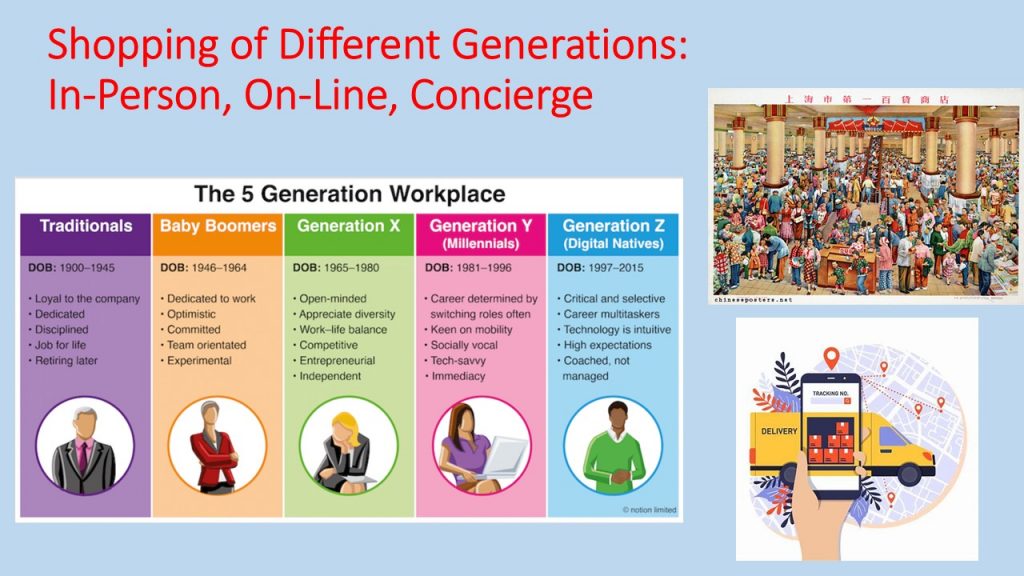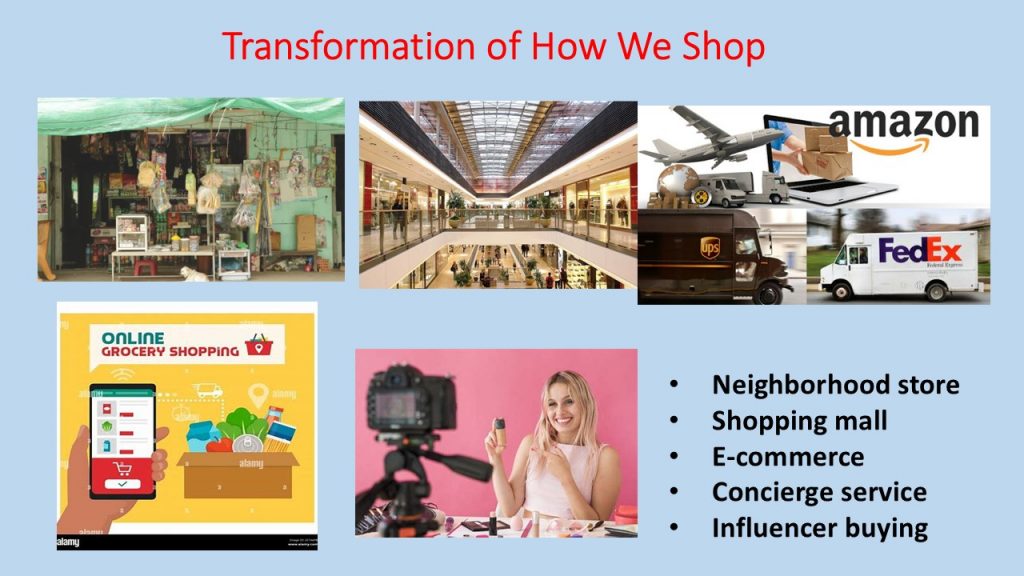
169. How Do You Shop? | 從巷口柑仔店到線上電商
– Musings of Dr. Jamie C. Hsu, 2.28.2025
Depending on your age and lifestyle, you may have experienced different ways of shopping for your personal needs and groceries. Over the decades, various ways of shopping have emerged, declined, or disappeared.
In the early days — particularly for the baby boomer generation and those in rural areas — we primarily relied on street-corner shops or general stores to supply our daily necessities. The contents of the shops reflected the needs of the people living in the neighborhood. The owners were very customer-focused and flexible in their inventory and often did special orders to satisfy a particular need. Such stores often became gathering places and information centers for townspeople.
As time progressed and people moved into cities, bigger department stores and shopping malls became prevalent. Such big-box stores carried almost everything you needed to furnish a household and sustain a comfortable lifestyle, from appliances and hardware to clothing, toys, and furniture. Many members of Gen. X would take their whole family to browse through these stores, making it a field trip.
As time progressed, dual-income families became more prevalent, and their time was more rushed. E-commerce emerged as a more time-efficient way of shopping. The COVID-19 pandemic triggered a new wave of contactless shopping. Today, we are seeing e-commerce businesses take over a big portion of supplying our shopping needs. Delivery trucks from Amazon, UPS, FedEx, and many local merchants are everywhere. A new industry and new breed of workers are serving Gen. Y and millennials, contributing to the decline of many traditional retail stores.
The emergence of the internet and social media has introduced another new phenomenon: concierge services that take orders, make purchases, and arrange pickups and deliveries. This is done by the stores themselves or through third-party services. This has alleviated the time constraints of many dual-income couples and people with rigid working schedules. At the same time, it has created income opportunities for many more people.
Nowadays, Gen. Z’s purchases are often swayed by social media “influencers” promoting specific merchants. The pre-order and mass-purchase model has allowed some new businesses to minimize capital, sales force, or inventory. Although such “virtual stores” could be short-lived and transient, they introduce a new shopping phenomenon in the digital age.
The above shopping methods all have different advantages and disadvantages, providing varying degrees of enjoyment or frustration. I hope you have experienced it and found the best one for you.


從巷口柑仔店到線上電商 (2025/2/28)
–作者 許俊宸博士
–中譯 薛乃綺
過去幾年根據你的年齡跟生活型態,你可能體驗過很多種不同的購物方式,尤其是買日用品和雜貨的時候。過去幾十年來,購物的方式不斷出現新花樣,有些紅極一時、有些逐漸沒落,有些甚至完全消失了。
在早期,像嬰兒潮世代的人,或是住在鄉下地方的人,大家通常都會到街角的小商店或雜貨店買生活必需品。這些店裡賣的東西,通常都很符合附近居民的需求,老闆也特別親切,會根據你的要求去特別訂貨。有時候,這種小商店還會變成當地人的聚會場所和情報交流中心呢!
隨著時代演進,越來越多人搬進城市,大型百貨公司和購物中心就開始盛行了起來。這些大賣場裡什麼都有,從家電、五金用品、衣服、玩具到傢俱,應有盡有。很多X世代的人,小時候都會全家一起去逛這種大賣場,逛上一整天,感覺就像個小型家庭旅遊一般。
再後來,雙薪家庭變多了,大家時間也越來越趕。這時候,「電子商務」這種省時又便利的購物方式出現了。尤其是新冠肺炎疫情爆發後,「零接觸」購物更是變成新潮流。現在到處都可以看到Amazon、UPS、FedEx這些快遞公司和許多本地店家派出的貨車,跑遍各個街頭。電子商務這個新行業,創造了許多新工作,滿足了Y世代和千禧世代的需求,卻也導致許多傳統商店逐漸沒落。
因為網路和社群媒體的普及,又出現了另一種新現象:專門替人跑腿買東西的「代買服務」。不管是店家自己還是第三方服務,都能幫你接單、買東西、安排取貨或送貨,這對時間不夠用的雙薪家庭或上班時間比較固定的人來說,真的省了不少麻煩。同時,也幫許多人提供了工作機會。
現在呢,Z世代買東西常常會受到社群媒體上網紅的影響。他們推薦特定的商家,鼓勵大家預購或團購,讓許多新店家不用花大錢準備庫存,也不用雇用一大堆銷售人員。雖然這些「虛擬商店」可能只是曇花一現,但卻是數位時代的特殊購物方式。
以上每一種購物方式都有各自的優缺點,也各有各的趣味跟不足之處。希望你已經體驗過這些不同的方式,也找到最適合你的購物樂趣囉!


